This web lab was adapted from materials from Joan Carlson, Jack Doepke, Judy Jones and Randyll Warehime.
Background
In this web lab, students explore how much variety in phenotype can be produced by a very limited genotype (only 30 traits). The traits in this web lab show several different inheritance patterns. These inheritance patterns are simplified representations of real inheritance patterns. The traits in the aliens in this web lab show the following inheritance patterns:
- Dominant—Traits that appear to mask (or hide) other traits.
- Recessive— Traits that can be hidden in one generation and then appear in the next.
- Incomplete dominance—Traits in which the heterozygote shows a different phenotype from the homozygous dominant phenotype.
- Polygenic—Traits in which several genes contribute to the overall phenotype.
- Epistasis—The interaction of two genes in which one hides the effects of another.
The Web Lab
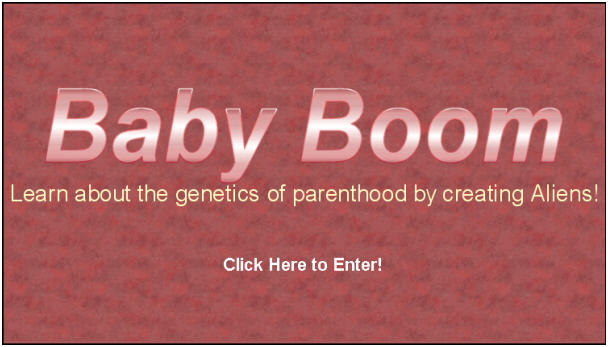
Introduction
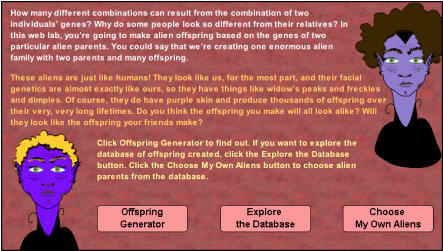
The text on this screen reads, “How many different combinations can result from the combination of two individuals’ genes? Why do some people look so different from their relatives? In this web lab, you’re going to make alien offspring based on the genes of two particular alien parents. You could say that we’re creating one enormous alien family with two parents and many offspring. These aliens are just like humans! They look like us, for the most part, and their facial genetics are almost exactly like ours, so they have things like widow’s peaks and freckles and dimples. Of course, they do have purple skin and produce thousands of offspring over their very, very long lifetimes. Do you think the offspring you make will all look alike? Will they look like the offspring your friends make? Click Offspring Generator to find out. If you want to explore the database of offspring created, click the Explore the Database button. Click the Choose My Own Aliens button to choose alien parents from the database.”
By choosing the Offspring Generator button, students will create their own alien offspring by flipping a coin to determine which alleles that offspring will inherit from its parents. The Explore the Database button will allow students to explore graphs of the numbers of aliens in the database of 100 aliens by genotype and phenotype. The Choose My Own Aliens button will allow students to examine the traits of the 100 aliens in the database and choose two different parents for their offspring.
Offspring Generator
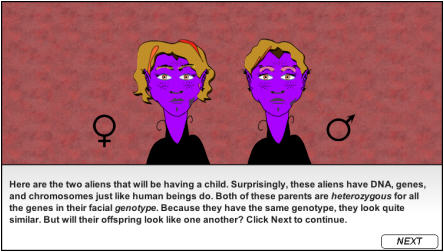
In this section of the web lab, students flip a coin to determine the traits that their alien offspring will inherit. The alien parents are both heterozygous for all the genes in their facial genotype.
The first coin flip determines whether the offspring inherits an X or a Y chromosome from the father and, thus, determines the offspring’s sex. Students then determine the thirty traits in the facial phenotype by flipping a coin for each allele inherited from the parents. Some of the traits are polygenic, so more than thirty flips are required to complete the offspring. As the student progresses through, the picture of the alien face is filled in. After a trait is determined by coin flips, the Show Trait/Hide Trait button appears below the picture of the offspring. If a student misses the appearance of a trait, he or she can hide the trait, then show it again to see how the alien face changes. The table at the end of this document shows the various phenotypes and genotypes that the aliens can display. After flipping the coin to determine the traits of one alien offspring, students may want to use the Finish Alien >> button to complete subsequent offspring. The Finish Alien >> button randomly determines the alleles contributed by each parent.
After students have completed their alien offspring, they can print out the image and the genotype. They can use the printouts to compare offspring with their classmates and get a feel for the variety that can be produced by just 30 separate traits.
Explore the Database
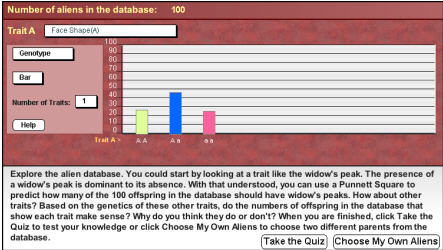
In this section of the web lab, students can query the database of 100 alien offspring to see what traits appear and how frequently. Students select which trait or traits they would like to see displayed on the graph using the pulldown menu labeled Trait A. They can then choose whether they would like the graph to present genotype or phenotype, whether they want a bar or a pie chart, and how many traits they would like to see displayed (1 or 2). If they choose to display two traits at a time, the graph displays only phenotypes. Numerical values for each bar are displayed when the cursor is positioned over a bar.
In this section, students can use the graphs to determine whether a trait follows a particular model of inheritance. For example, simple dominant/recessive traits should show a 3:1 ratio of dominant to recessive phenotypes, while incompletely dominant traits show a 1:2:1 ratio. Students can use Punnett Squares to determine expected ratios, then query the database to see if the numbers conform. If not, they can try to figure out what model of inheritance a trait does follow. See the trait table at the end of this document for the inheritance patterns of each trait.
Choose My Own Aliens
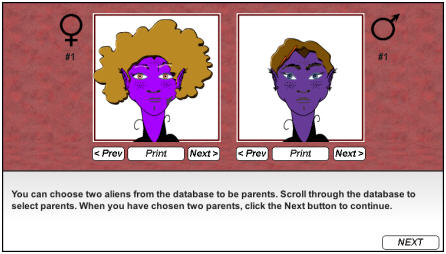
In this section of the web lab, students can choose two aliens from the database to act as new parents. They can explore the offspring of alien parents with genotypes that they choose.
The < Prev button moves backward through the database, while the Next > button moves forward. The Print button allows the student to see the genotype and phenotype of each alien and print out the alien if so desired. After the student has selected two new parents, he or she clicks the Next button to begin to create an alien offspring with the chosen aliens as parents.
Each alien in the database is numbered, so that students can choose the same aliens repeatedly or multiple students in the class can choose the same alien parents. By exploring the variety of offspring produced by the pairing of two aliens, students can see how the genotypes of the parents affect the variability of the offspring. For example, if students choose a female alien with many homozygous dominant traits, the offspring should all exhibit the same phenotype for traits that show a dominant/recessive inheritance patterns.
Take the Quiz
In this quiz, students use the graphs to explore the database. By examining the numbers of alien offspring that exhibit certain phenotypes/genotypes, students try to determine the inheritance patterns of particular traits.
Question 1
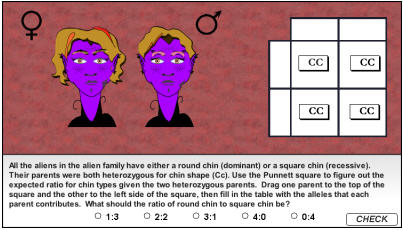
All the aliens in the alien family have either a round chin (dominant) or a square chin (recessive). Their parents were both heterozygous for chin shape (Cc). Use the Punnett square to figure out the expected ratio for chin types given the two heterozygous parents. Drag one parent to the top of the square and the other to the left side of the square, then fill in the table with the alleles that each parent contributes. What should the ratio of round chin to square chin be?
Using the Punnett square, students should discover that the ratio should be three round chins (CC, Cc, cC) to one square chin (cc).
Question 2
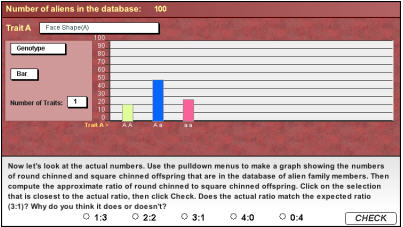
Now let’s look at the actual numbers. Use the pulldown menus to make a graph showing the numbers of square chinned and round chinned offspring that are in the database of alien family members. Then compute the approximate ratio of square chinned to round chinned offspring. Click on the selection that is closest to the actual ratio, then click Check. Does the actual ratio match the expected ratio (3:1)? Why do you think it does or doesn’t?
Students will have to select the chin shape trait from the pulldown menu and then change the display to phenotype to see the ratio.
Question 3
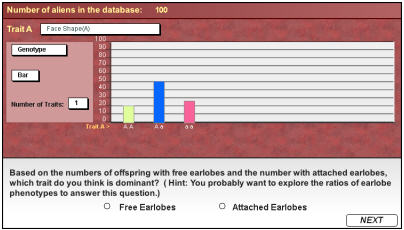
Based on the numbers of offspring with free earlobes and the number with attached earlobes, which trait do you think is dominant? (Hint: You probably want to explore the ratios of earlobe phenotypes to answer this question.)
To answer this question, students should make a graph of the phenotypes of the trait labeled Earlobe (H). If they do so, they should find that the ratio of Free to Attached is about three to one, suggesting that free earlobes are dominant to attached earlobes in the alien population.
Question 4
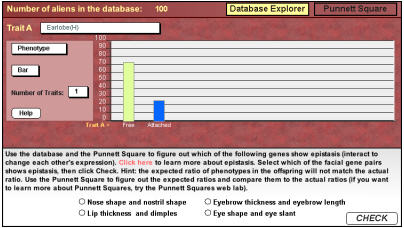
Use the database and the Punnett Square to figure out which of the following genes show epistasis (interact to change each other's expression). Click here to learn more about epistasis. Select which of the facial gene pairs shows epistasis, then click Check. Hint: the expected ratio of phenotypes in the offspring will not match the actual ratio. Use the Punnett Square to figure out the expected ratios and compare them to the actual ratios (if you want to learn more about Punnett Squares, try the Punnett Squares web lab).
Students can explore the expected Punnett Square for each pair of traits by clicking on the Punnett Square button in the upper right hand corner of the screen. By determining what the expected ratio should be and comparing it to the actual ratio, they should be able to determine that the eyebrow thickness trait and the eyebrow length trait are an example of epistasis. The actual ratio of phenotypes should be:
- 9 bushy, unconnected eyebrows (Z?A?)
- 3 bushy, connected eyebrows (Z?aa)
- 3 fine, unconnected eyebrows (zzA?)
- 1 fine, connect eyebrow (zzaa)
Students should recognize from the graph that none of the offspring in the database has bushy, connected eyebrows. They can also look at the eyebrow length trait alone and should see that there are too few offspring with connected eyebrows if the trait follows a dominant/recessive pattern of inheritance.
Please see .PDF version of teacher's manual for the Trait Table. (go to 'Download Teacher's Notes' in Baby Boom Directory)
Glossary
Epistasis
The suppression of a gene by the effect of an unrelated (epistatic) gene.
Heterozygous
Having two different alleles for a given trait.
Homozygous
Having the same alleles for a given trait.
Genotype
The particular genetic pattern seen in the DNA of an individual.
Traits
Distinguishing characteristics.
| Back to Web Lab Directory |